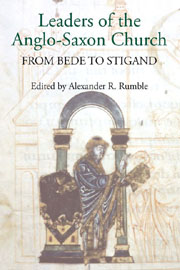Book contents
- Frontmatter
- Contents
- List of Illustrations
- Preface
- Contributors
- Abbreviations
- Introduction: Church Leadership and the Anglo-Saxons
- 1 Bede and the Early English Church
- 2 Archbishop Ecgberht and his Dialogus
- 3 Abbatial Responsibility as Spiritual Labour: Suckling from the Male Breast
- 4 Understanding the Earliest Bishops of Worcester c. 660–860
- 5 The Role of Bishops in Anglo-Saxon Succession Struggles, 955 × 978
- 6 Image-Making: Portraits of Anglo-Saxon Church Leaders
- 7 ‘To Keep Silence Following the Rule's Command’: Bishop Æthelwold, Reforming Ideology and Communication by Signs
- 8 Wulfsige of Sherborne's Reforming Text
- 9 From Winchester to Canterbury: Ælfheah and Stigand – Bishops, Archbishops and Victims
- Index
Introduction: Church Leadership and the Anglo-Saxons
Published online by Cambridge University Press: 05 February 2013
- Frontmatter
- Contents
- List of Illustrations
- Preface
- Contributors
- Abbreviations
- Introduction: Church Leadership and the Anglo-Saxons
- 1 Bede and the Early English Church
- 2 Archbishop Ecgberht and his Dialogus
- 3 Abbatial Responsibility as Spiritual Labour: Suckling from the Male Breast
- 4 Understanding the Earliest Bishops of Worcester c. 660–860
- 5 The Role of Bishops in Anglo-Saxon Succession Struggles, 955 × 978
- 6 Image-Making: Portraits of Anglo-Saxon Church Leaders
- 7 ‘To Keep Silence Following the Rule's Command’: Bishop Æthelwold, Reforming Ideology and Communication by Signs
- 8 Wulfsige of Sherborne's Reforming Text
- 9 From Winchester to Canterbury: Ælfheah and Stigand – Bishops, Archbishops and Victims
- Index
Summary
FROM the time of the late sixth-century mission led by Augustine, who had been sent by the bishop of Rome to convert the pagan Anglo-Saxons to Christianity, the church in England was intended to follow a territorial pattern, like that already established on the Continent and previously in Roman Britain, based on the diocese and administered by bishops. Groups of such dioceses would be subject to a metropolitan and within each diocese there could be ecclesiastical centres (monasteria, ‘minsters’ mostly led by abbots or abbesses) of lesser status than the bishop's cathedral and whose clergy would be under his higher authority. The structure was hierarchical, its justification stemming from powers invested in St Peter, the first bishop of Rome, by Christ himself.
Although the administrative system that eventually emerged in England was not identical with the Continental one, the two archdioceses of Canterbury and york having an unequal number of satellites, the expected episcopal and abbatial nature of leadership within the church was common to the whole country, even when the latter was still divided into a number of secular kingdoms. The Anglo-Saxon pattern was also different from that of the Romano-British and Irish churches. Cathedrals were not always in major urban centres as in late Roman Britain, though many were, and there was a clear distinction made between the offices of bishop and abbot such as was not always present in the early Irish church and its foundations in northern and western Britain.
- Type
- Chapter
- Information
- Leaders of the Anglo-Saxon ChurchFrom Bede to Stigand, pp. 1 - 24Publisher: Boydell & BrewerPrint publication year: 2012

